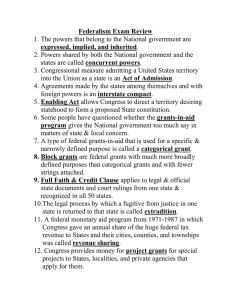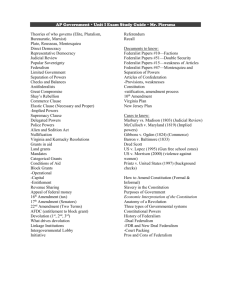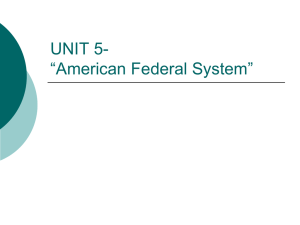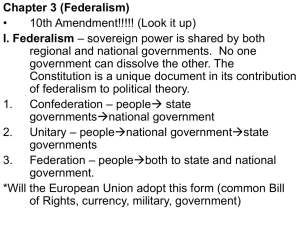Federalism
advertisement
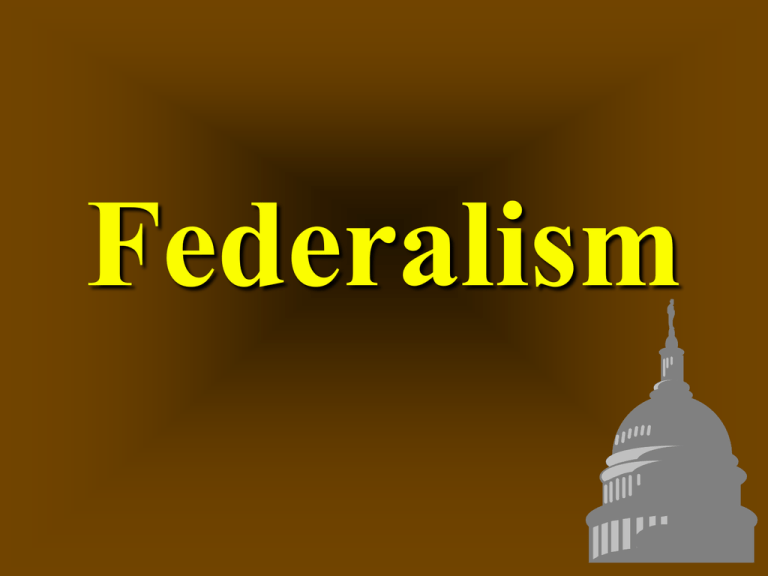
Federalism Government Units 29,481 Special Districts 50 States 3,042 Counties 19,205 Municipalities 16,691 Towns 14,741 School Districts Federalism Definition: a system of government in which a written constitution divides the powers of government on a territorial basis, between a central government and several regional governments usually called states or provinces. Checks the growth of tyranny. Allows unity without uniformity. Encourages experimentation. Keeps government closer to the people. FEDERALIST No. 28 Alexander Hamilton believed that people could shift their support between state and federal levels of government as needed to keep the two in balance. “If their rights are invaded by either, they can make use of the other as the instrument of redress.” Formal Constitutional Framework • The national government has only those powers delegated to it by the Constitution. • The national government is supreme. • The state governments have residual powers; meaning those neither assigned to the national government nor denied to the states. • Some powers are specifically denied to both the national government and the state governments. Delegated Powers • Those powers specifically assigned to the Federal Government. The founding fathers feared a national government that would overstep its bounds, so they took care to only allow the national government very specific powers. These are also referred to as enumerated powers. Implied Powers • These are powers that are NOT specifically delegated in the Constitution, but are understood to be necessary or allowed. The elastic clause or necessary and proper clause allows these by stating that Congress has the power "to make all laws which shall be necessary and proper for carrying into execution the foregoing powers" (art. I, sec. 8). Inherent Powers • Are those powers that belong to the National Government because it is the national government of a sovereign state in the world community. Denied Powers • These are powers that are specifically NOT allowed to either the federal or state governments. Again, this listing of denied powers was a specific way in which the founding fathers attempted to create a limited government. Powers Denied to the States • Making treaties with foreign governments. • Authorizing private persons to prey on the • • • • • shipping and commerce of other nations. Coining money, issuing bills of credit, or making anything but gold and silver coin legal tender in payment of debts. Taxing imports or exports. Taxing foreign ships. Keeping troops or ships in time of peace. Engaging in war. Powers Denied to the Federal Government • Levy duties on exports. • Take private property for public use without the • • • • • payment of just compensation. Prohibit freedom of religion, speech, press, or assembly. Conduct illegal search or seizures. Deny any person accused of a crime a speedy and public trial or trial by jury. Create a public school system for the nation. Enact uniform marriage and divorce laws. The Tenth Amendment “The powers not delegated to the U.S. by the Constitution…are reserved to the states respectively, or to the people.” Reserved Powers Clause Reserved Powers • To reserve is to save, in this case all powers not specifically delegated to the Federal Government are to be reserved or saved for the State Governments. Exclusive & Concurrent Powers • Exclusive means “available to only one person or group”, can only be exercised by the National Government. • Concurrent means "at the same time", in this case concurrent powers are those that both the federal and state governments have simultaneously. Examples of Powers Powers of the National Government (Delegated Powers) Powers of the States (Reserved Powers) Declare War Establish and Maintain Schools Maintain Armed Forces Establish Local Governments Regulate Interstate and Foreign Trade Conduct Elections Admit New States Regulate Business Within the State Establish Post Offices Make Marriage Laws Coin Money Provide for Public Safety Establish Foreign Policy Assume Other powers not Delegated to the National Government of Prohibited to the States Make All Laws Necessary and Proper for Carrying out Delegated Powers Powers Shared by State and National Government (Concurrent Powers) Maintain Law and Order Provide for Public Welfare Levy Taxes Establish Courts Borrow Money Create Banks Article Six – Sovereignty of the United States Constitution • In all instances where the federal (or national) law comes into conflict with state or local laws, the laws of the United States Constitution reign Supreme. • The Constitution states that it is “the supreme law of the land.” • Federal laws always take priority; therefore, if a federal law forbids the growing, sale, or use of marijuana, IT IS ILLEGAL, no matter what the state of Colorado or Oregon says. • The Supreme Court is the umpire in the federal system. One of its chief duties is to apply the Supremacy Clause to the conflicts that the dual system of government creates. McCulloch v. Maryland (1819) In 1819 McCulloch v. Maryland, Chief Justice John Marshall considered whether Congress had the power to incorporate a Bank. He wrote: Since the Constitution had given Congress the power to “make all Laws which shall be necessary and proper for carrying into execution of the forgoing Power, the Bank of the United States was constitutional.” The Supremacy Clause The other issue: whether the state of Maryland could tax a branch of the Bank of the United States. Since the Constitution and federal laws were supreme under the Supremacy Clause of Article VI, they took precedence over the laws of the states. “A state cannot tax those subjects to which its sovereign powers do not extend..the power to tax involves the power to destroy.” Gibbons v. Ogden (1824) First case to involve the Constitution’s interstate commerce clause. Chief Justice Marshall construed Gibbon’s federal license to nullify Ogden’s state one. Thus, he broadly defined the national government’s power to regulate commerce, consequently restricting the power of the states. The Civil War One major historical event settled the issue of national supremacy versus states’ rights. The Civil War made it clear that the national government is supreme—its sovereignty derives directly from the people and thus, states cannot secede. The Nation’s Obligations to the States Republican Form of Government • The Constitution requires the National Government to “guarantee to every State in this Union a Republican Form of Government.” Invasion and Internal Disorder • The National Government is also required to provide defense of the States from foreign invasion, and aid in protecting against “domestic Violence” in the States. Respect for Territorial Integrity • The National Government is constitutionally bound to respect the territorial integrity of each of the States. Admitting New States • Only Congress has the power to admit new States to the Union. • Congress first passes an enabling act, an act directing the people of the territory to frame a proposed State constitution. • If Congress agrees to Statehood after reviewing the submitted State constitution, it passes an act of admission, an act creating the new State. Federalism through History DUAL FEDERALISM 1787 to late 1930’s A 19th century concept of government recognizing a duality of power between the national and state governments, each having a distinct sphere of authority and jurisdiction. Federalism through History COOPERATIVE FEDERALISM 1930’s to 1970’s The interpretation is characterized by a sharing of governmental powers for the purpose of joint problem solving. Emergence of a National Economy Federal-state distinctions much harder now. Insurance companies sold policies to customers both inside and outside a given state. There were different laws regulating identical policies that happened to be purchased from the same company by persons in different states. This didn’t make a lot of sense. The New Deal The New Deal set forth a program that was dictated at the national level but carried out at the state level. The new legislation included massive job programs that provided work for unemployed Americans. Other programs, like Aid to Families with Dependent Children (AFDC) and Social Security, offered assistance to people who could not work. Thus, the states and federal government became to be seen as partners. The Great Society The legacy of Roosevelt’s New Deal continued with President Lyndon Johnson’s “War on Poverty” three decades later. •Food Stamps •Medicare •Medicaid Nixon President Richard Nixon also advanced the New Deal and Great Society: • established the Supplemental Security Income program • expanded the food stamp program • created the Environmental Protection Agency (EPA) in 1970 to enforce laws such as the Clean Air Act (1963). Federalism through History CREATIVE FEDERALISM 1970’s & 80’s A form of cooperative federalism extending federal grants-in-aid beyond general governments to special districts and private organizations. Federalism through History NEW FEDERALISM 1980’s & 90’s Proposal to return social and economic programs from the federal government to the states. DEVOLUTION FISCAL FEDERALISM The shared responsibility between the national, state (and local) governments for taxing and spending policies. FEDERAL LOCAL INCOME TAX PROPERTY TAX STATE SALES TAX Unfunded Mandates •Brown v. Board of Education of Topeka, Kansas •Americans with Disabilities Act of 1990 •Motor Voter Act of 1993 •Americans with Disabilities Act required businesses and state governments to provide the disabled with equal access to services, buildings, and transportation systems. Cooperative Federalism Even though the basis of federalism is the division of powers between levels of government, there is still much cooperation between them. Purposes of Federal Grants To supply state and local governments with revenue Purposes of Federal Grants To supply state and local governments with revenue To establish minimum national standards Purposes of Federal Grants To supply state and local governments with revenue To establish minimum national standards To equalize resources among the states, on the “Robin Hood Principle” of taking, through federal taxes, money from people with high incomes and spending it, through grants, in states where the poor live Purposes of Federal Grants To supply state and local governments with revenue To establish minimum national standards To attack national problems yet minimize the growth of federal agencies To equalize resources among the states, on the “Robin Hood Principle” of taking, through federal taxes, money from people with high incomes and spending it, through grants, in states where the poor live Purposes of Federal Grants To improve the operation and levels of services of states and local governments Purposes of Federal Grants To improve the operation and levels of services of states and local governments To encourage the achievement of social objectives such as nondiscrimination Purposes of Federal Grants To improve the operation and levels of services of states and local governments To stimulate experimentation and new approaches To encourage the achievement of social objectives such as nondiscrimination Purposes of Federal Grants To improve the operation and levels of services of states and local governments To stimulate experimentation and new approaches To encourage the achievement of social objectives such as To attack major problems nondiscrimination but minimize the growth of federal agencies Federal Aid Highway Act of 1956 – building highways and construction. The national government financed 90% of the cost. 1974 Emergency Highway Energy Conservation Act – States had to agree to limit highways speeds to 55 mph if they wanted to receive funding for highway repair. A 1984 highway law withholds funds from states that do not enact minimum drinking age of 21 and mandatory sentences for drunk drivers. Types of Grants Categorical Grants Project Grants Block Grants Revenue Sharing Types of Grants Categorical Grants Categorical grants are made for some specific, closely defined purpose, such as school lunch programs or the construction of airports or water treatment plants. There are usually conditions, or “strings,” attached to regulate the use of these funds. Elementary & Secondary Education Act – Provided money for reading, special education and support programs for public school. Types of Grants Project Grants Project grants are provided to States, localities, and sometimes private agencies that apply for them. They are used for a variety of purposes ranging from medical research to job training and employment programs. Federal Aid Highway Act of 1956 – building highways and construction. The national government financed 90% of the cost. Types of Grants Since 1974 Community Development Block Grant Program provided a flexible source of annual grant funds for local governments nationwide. Block grants are portions of money allocated to States to use for broader purposes, such as health care, social services, or welfare. Block grants often are granted with fewer strings attached. Types of Grants State and Local Assistance Act of 1972 initially delivered $4 billion per year in matching funds to states and municipalities. The program, which distributed some $83 billion dollars before it was killed by Ronald Reagan in 1986, proved enormously popular. Revenue Sharing Interstate Relations • Full faith and credit • Privileges and immunities • Extradition • Interstate compacts



